#Rascal Does Not Dream of Siscon Idol
Text
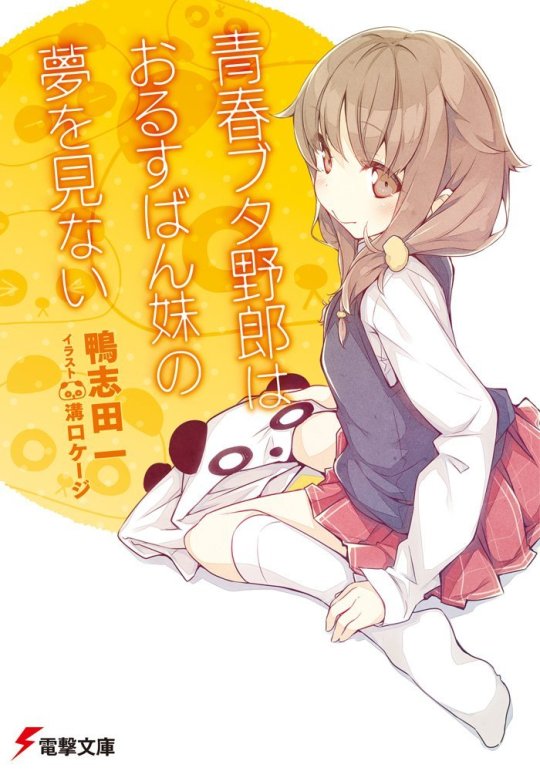

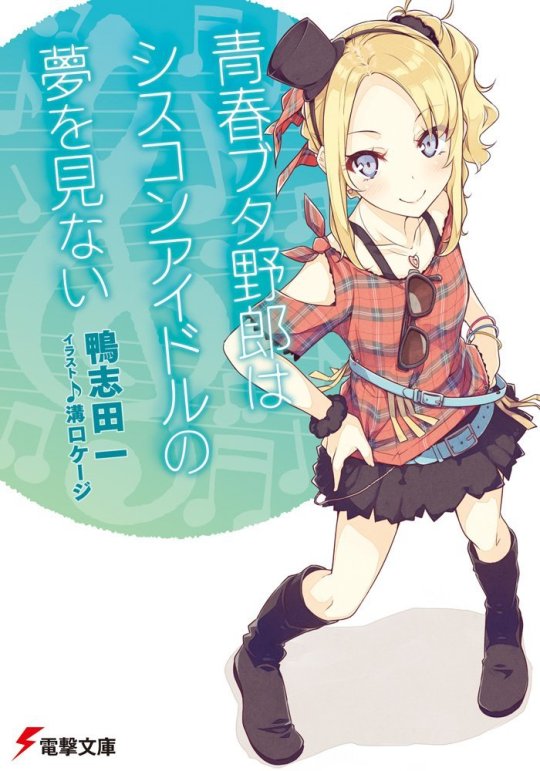
#oficial art#aobuta series#aobuta#seishun buta yarou series#seishun buta yarou wa yumemiru shoujo no yume wo minai#seishun buta yarou wa bunny girl senpai no yume wo minai#rascal does not dream#rascal does not dream of a dreaming girl#rascal does not dream of bunny girl senpai#Seishun Buta Yarou wa Odekake Sister no Yume wo Minai#Seishun Buta Yarou wa Siscon Idol no Yume wo Minai#azusagawa kaede#kaede azusagawa#青ブタ#shoko makinohara#makinohara shoko
7 notes
·
View notes
Text
0 notes
Photo



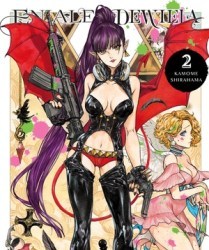


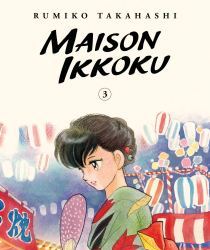

Reader’s Corner: Carole & Tuesday, Rascal Does Not Dream of Siscon Idol, and The Rampage of Haruhi Suzumiya
Rascal Does Not Dream of Siscon Idol (Rascal, Vol. 4)
My most consistent complaint about the Rascal series, which I otherwise find charming, is that the stories are too full of contrivances. with plots points and character actions often making little sense. Though these developments are often small, such as an explanation that the sisters at the center of this volume aren’t apologizing to each other after a fight because neither would accept such apologies, when that hardly seems true, the way they impact character development and the plot by changing both for the sake of reaching certain resolutions and mile markers in the text, rather than letting the characters and their situations play out naturally, is frequent and significant. The same issue continues, though thankfully at a lesser extent, with Siscon, the fourth volume of the Rascal series, which introduces Mai’s half-sister, Nodoka, an idol in her own right but one far less famous than her actress sister. Both are impacted by Adolescent Syndrome in this volume, switching bodies and being forced to act as one another in different realms and levels of show business. The dialogue between Sakuta and Nadoka is almost as delightful as between him and Mai, and features frequently throughout the text in this fun and warm read which continues the series’ delightful balance between playful adolescence and development of authentic relationships between characters, in whom I’m now fully invested. ~ Twwk
Rascal Does Not Dream of Siscon Idol is published by Yen Press.*
Yokohama Station SF
Not every robot overlord is like Skynet, intent on killing all humanity, with android enforcers that are nigh impossible to kill. Sometimes, the enforcers are turnstiles that not only keep the ticketless out of the station but eject rules violaters to unoccupied spaces to meet their deaths by starvation, and sometimes the master computer is just railroad infrastructure consuming the entire island of Honshu via slow, automated urban renewal. This unique and immensely absorbing post-apocalyptic novel begins long after the “Winter War” devastated Earth, and Yokohama Station, a concrete and metal structure growing seemingly without end, has covered almost all of Honshu and threatens the neighboring islands. Hiroto, lives on a sliver of land just outside the behemoth structure on a tiny beach community until an “Insider,” ejected from within the station, gives him a chance to explore the vast unit for five days, also charging him with finding a resistance leader, while he brings in a personal quest of his own. From the description, you may sense both Terminator and Ready Player One vibes, though its more similar in tone and eventually story to the latter, though cutting out that work’s affection for nerd culture and replacing it with efficient writing. Yokohama Station SF features a clever and well-crafted but familiar world, interesting artificial intelligence units—always a plus for me—and believable science fiction, having been written by an actual scientist, Yuba Isukari. Yokohama Station SF is his first novel, and as a compelling piece of sci-fi with anime sensibilities, it is a significant achievement. Paraphrasing another overlord of a sci-fi franchise, I shall be watching Mr. Isukari’s career with great interest. ~ Twwk
Yokohama Station SF is published by Yen Press.*
Love of Kill, Vol. 1
The quiet, beautiful Chateau Dankworth is a bounty hunter, working for an organization that contracts with mafia families to eliminate targets. Ryan-Ha Song is also an assassin, but an especially notorious one, skilled and feared for his prowess. When these two become entangled, it’s not in a deathmatch—it’s because the enigmatic Song wants to date Chateau! Volume one of Love of Kill features plenty of action and establishes the deadly world in which the protagonists work, but otherwise gives very little information about the two. Structurally and thematically, the opening volume is engaging, functioning through leaps back and forth in time and filled with grisly episodes of violence. It’s quite jarring, most particularly when the volume mixes in a romantic interlude between the leads that feels as awkward to readers as it does to Chateau, and for the same reason: Song appears to be entirely psychotic. That also makes it hard to root for the killer, while younger assassin displays so little personality that she’s also difficult to care for. With such coldness, it’s hard to imagine why this manga, which in its initial version was published through the Japanese art site, Pixiv, necessitated a fuller release. Perhaps future volumes will reveal that answer, but for now, the tale of Pixiv to published is the most engaging part of this manga. ~ Twwk
Love of Kill is published by Yen Press.*
Eniale & Dewiela, Vol. 2
This second volume of this very silly series continues within the same framework of gags from volume one. In one story, Eniale causes havoc to the world by using supernatural noises to create sonar in an attempt to find Dewiela’s earring, which she’s lost. This humorous storyline and other chapters also provide a view into the interesting cosmos of this version of the world. While Eniale and Dewiela represent the Lord and Satan, respectively, from a Christian framework, this world setting has other deities and belief structures both existing and being true concurrently. Eniale and Dewiela are trying to reap souls for their respective afterlife locales, while local deities they encounter are pushing back, saying that the local souls belong to them. The duo face especially harsh pusbback by local deities when they enter Japan. The most interesting story comes from the tale of a Catholic priest who, according to Heaven, may become an angel one day to battle during Armageddon. However, something changed in his life and Eniale is sent to investigate. This bittersweet tale ends, as usual, on a gag, reflecting how fun this series is overall, even if it’s theology is just wildly inconsistent. ~ MDMRN
Eniale & Dewiela Vol. 2 is published by Yen Press.*
Carole & Tuesday Vol. 2
Volume two of Carole & Tuesday has the titular girls experiencing new challenges on their way to recognition and success in the music business, but it opens with a focus on a third girl. Angela, a child prodigy famous for modeling, wants to try something different and to become a singer. The manga shares some of her backstory and how she teams up with Tao, a man of mystery who creates popular songs using A.I. He riles up Angela throughout the manga, pushing her (rudely) to try harder. Meanwhile, Carole and Tuesday are try to get DJ Ertegun to listen to their song, which he refuses. Later, they struggle to find harmony on a new song, and take a little break outside on their own, considering their journey up to that point. When they return to their apartment, their slovenly manager, Gus, convinces them to enter the Mars Brightest competition. It’s like American Idol, but on Mars! Angela also enters in the test that will show how skilled these three girls really are as singers. I’ve seen the anime so I knew what to expect, but the manga still entertained me, particularly with its fantastic artwork. The panels pop out and feature intricate detail, connecting more with the characters through the facial expressions, dialogue, and the challenges they face. ~ Samuru
Carole & Tuesday Vol. 2 is published by Yen Press.
The Rampage of Haruhi Suzumiya (Haruhi Suzumiya, Vol. 5)
Having watched the episodes, but never having read the novel from which they were adapted, I expected the “Endless Eight” story to be much like the anime version: repetitive, dull, and overly long. It is in fact none of these things, taking up just 1/4 of The Rampage of Haruhi Suzumiya, the fifth light novel in the Haruhi Suzumiya series. While I still admire KyoAni’s decision to spend eight episodes on almost identical material to reflect the time loop aspect of the story (this despite the disastrous reaction it received), the much shorter chapter in Rampage doesn’t need the repetition to convey the peril and anxiety of the situation. It’s an excellent story, joining the funnier material in “The Day of Sagittarius” and “Snowy Mountain Syndrome,” the longest story in the series so far, which initially feels like material already covered but in a winter setting, though it later reveals itself to be a story that not only reminds us of how Nagaru Tanigawa excels as a science fiction writer, introducing further elements of the genre into his work, but also one that conveys serious heart. The last story provides another one of Haruhi’s sincere explanations of her behavior to Kyon and heavily features character development of Nagato, as subtle as it is, which is equal parts uplifting and mysterious. ~ Twwk
The Rampage of Haruhi Suzumiya is published by Yen Press.*
Maison Ikkoku Collector’s Edition, Vol. 3
Some forty years after it was first published, these chapters from volume three of Maison Ikkokku Collector’s Edition show precisely why this romantic comedy is so beloved, displaying the full retinue of humor and charm that are pervasive throughout the series. This volume continues to demonstrate Rumiko Takahashi’s talent at using misunderstandings to develop strong comedic content, which then gives way to reveal her character’s personalities and hearts. With Godai now knowing Kyoko quite well, but still miserably immature in his outlook on romance, he struggles to “make the leap” into a relationship with her, but each chapter shows that despite the obstacles that get in their way—some significant and others more figmental—the two are more and more making connections between their hearts. And as laugh out loud funny as many of the panels are, it’s these moments of caring, which increasingly find their way into the lives of Godai, Kyoko, and the rest of the Maison Ikkoku residents, that make the series memorable, driving it closer and closer toward fulfillment while keeping us just far enough away to crank the angst up to 11. ~ Twwk
Maison Ikkoku Collector’s Edition is published by Viz.*
The World’s Finest Assassin Gets Reincarnated in Another World as an Aristocrat, Vol. 1
The world’s best assassin has run out of time—or has he? On the verge of retirement, he is tricked and killed during his last mission. But upon his death, the assassin appears before a goddess (what a surprise!) who needs him to do her a favor: Kill the hero of the world she’s in charge of before the hero causes trouble in the future for her and the world he is in. She chose the assassin because of his skill and allows him to be reborn whilst choosing his own skills. Much like Rudeus in Mushoku Tensei, this protagonist is reborn literally, as a baby, but retains his previous memories. As he grows up among a wealthy family of assassins in a world of magic and knights, he trains to become better and to prepare to face the hero. Along the way, he meets a girl named Dai who becomes his magic teacher and Tarte, whom he rescues from poverty (she eventually becomes his assistant/servant of sorts). Although it’s rather rushed and features fanservice moments I felt were unnecessary, I enjoyed volume one. It’s a good selection for fans of isekai, though not without some flaws. ~ Samuru
The World’s Finest Assassin Gets Reincarnated in Another World as an Aristocrat Vol 1. is published by Yen Press.
=====
Reader’s Corner is our way of embracing the wonderful world of manga, light novels, and visual novels, creative works intimately related to anime but with a magic all their own. Each week, our writers provide their thoughts on the works their reading—both those recently released as we keep you informed of newly published works and older titles that you might find as magical (or in some cases, reprehensible) as we do.
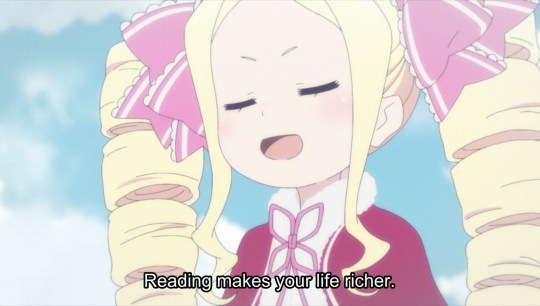
*Thank you to Yen Press and Viz Media for providing review copies.
#Manga#Lights Novels#Yokohama Station SF#Yokohama eki SF#Love of Kill#Koroshi Ai#Eniale & Dewiela#Carole & Tuesday#Haruhi Suzumiya#Suzumiya Haruhi#Maison Ikkoku#Rascal Does Not Dream of Siscon Idol#Seishun Buta Yarou wa Siscon Idol no Yume o Minai#The World’s Finest Assassin Gets Reincarnated in Another World as an Aristocrat#Sekai Saikou no Ansatsusha Isekai Kizoku ni Tensei suru#Reader's Corner#Articles#Author: TWWK#Author: MDMRN#Author: Samuru
30 notes
·
View notes
Text
Manga the Week of 3/31/21
SEAN: March ain’t going out like a lamb when it comes to manga.
ASH: True, that!
SEAN: Airship has two print books; Grimgar of Fantasy and Ash 14.5 and Mushoku Tensei 9.
Denpa’s website lists femme fatale: The Art of Shuzo Oshimi for next week. An artbook dedicated to the creator of Flowers of Evil, Blood on the Tracks and more.
They’ve also got The Girl with the Sanpaku Eyes 2 listed.
Ghost Ship has Yuuna and the Haunted Hot Springs 13.
No debuts from J-Novel Club, but we do get the 10th and final volume of The Combat Baker and Automaton Waitress. We also see Demon Lord, Retry! 6, The Epic Tale of Reincarnated Prince Herscherik 4, Holmes of Kyoto 4, My Instant Death Ability is So Overpowered, No One in This Other World Stands a Chance Against Me! 4, and The White Cat’s Revenge as Plotted from the Dragon King’s Lap 4. Desu.
Kaiten Books has a 2nd volume of My Dad’s the Queen of All VTubers?!.
Debuting in print for Kodansha is Chasing After Aoi Koshiba (Kyou, Koshiba Aoi ni Aetara), a yuri manga from Ichijinsha’s Comic REX. It’s got the writer of Masamune-kun’s Revenge (ehh…) and the artist of Bottom-Tier Character Tomozaki (yay!). A girl hopes to meet up with her first love at a reunion.
ASH: Seems like it has potential.
MELINDA: Agreed.
Also in print: Don’t Toy with Me, Miss Nagatoro 6, Heaven’s Design Team 4, The Quintessential Quintuplets 13, and Shikimori’s Not Just a Cutie 3.
Digitally we get two debuts. The first is She’s My Knight (Ikemen Kanojo to Heroine na Ore!?), which runs in Kodansha’s Palcy, and features a popular young man having to deal with falling in love with a girl more popular AND more manly than he is!
ANNA: This sounds amusing.
SEAN: We also get Those Snow-White Notes (Mashiro no Oto). This is a biggie, as it’s already 27 volumes in Japan. It’s multi-award winning, runs in Weekly Shonen Magazine, is by the author of Baby & Me and A Vampire and His Pleasant Companions, and is for the Shamisen what Chihayafuru is for Hyakunin Isshu. It also has an anime this spring!
MICHELLE: I’m super excited about this one!
ASH: I love shamisen so much.
MELINDA: Okay, I’m ready!
SEAN: And we get A Condition Called Love 7, Elegant Yokai Apartment Life 21, How Do You Do, Koharu? 2, I Want To Hold Aono-kun So Badly I Could Die 7, My Unique Skill Makes Me OP Even at Level 1 3, and Saint Young Men 11.
MICHELLE: I need to get caught up on several of these.
MELINDA: Same here.
SEAN: Seven Seas debuts two manga based on light novels they also have. Drugstore in Another World: The Slow Life of a Cheat Pharmacist (Cheat Kusushi no Slow Life: Isekai ni Tsukurou Drugstore) runs in Takeshobo’s Web Comic Gamma Plus, and is about… well, the title.
ASH: So many titles these days are helpful like that, perhaps overly so.
SEAN: And there is also ROLL OVER AND DIE: I Will Fight for an Ordinary Life with My Love and Cursed Sword! (“Omae Gotoki ga Maou ni Kateru to Omou na” to Yuusha Party o Tsuihou Sareta node, Outo de Kimama ni Kurashitai), which runs in Micro Magazine’s Comic Ride, and combines yuri and gore-filled grimdark quite nicely.
Seven Seas also has the digital debut of four more Alice books, which focus on Elliot March and Tweedle Dee/Dum. If I recall correctly, the Twins books were the smuttiest in the series.
ANNA: No thank you!
SEAN: They’ve also got BL Metamorphosis 4, the third and final volume of Ghostly Things, High-Rise Invasion 17-18, Himouto! Umaru-chan Vol. G1 (also a final volume, sort of – it’s a one-shot continuation), the fifth and final volume of How to Treat Magical Beasts: Mine and Master’s Medical Journal, Made in Abyss 9, Miss Kobayashi’s Dragon Maid 10, and Precarious Woman Executive Miss Black General 6.
MICHELLE: Someday I really will read BL Metamorphosis.
ASH: You really should! It is wonderful.
MELINDA: I also need to read it!
SEAN: Two debuts for Yen On. The first is a spinoff. I Was a Bottom-Tier Bureaucrat for 1,500 Years, and the Demon King Made Me a Minister (Hira Yakunin Yatte 1500-nen, Maou no Chikara de Daijin ni Sare Chaimashita) features Beelzebub and her demonic crew from I’ve Been Killing Slimes for 300 Years having adventures of their own.
The other is Yokohama Station SF, the story of a boy who is allowed to search the giant subway terminal that the world of Japan has become. This looks pretty cool, actually.
MICHELLE: It looks super cool! I always love stories about exploring sprawling structures (like BLAME, for example).
ASH: I’m definitely picking this one up! It looks like it should help fill the SF hole left by Viz’s Haikasoru imprint being on hiatus.
MELINDA: This one sounds so interesting!
Also out next week: 86 ~Eighty-Six~ 7, new reprints of the 5th and 6th Haruhi Suzumiya novels, The Hero Is Overpowered But Overly Cautious 6, and Rascal Does Not Dream of Siscon Idol (the 4th in the series).
Yen Press has many manga debuts next week. We start with Can’t Stop Cursing You (Dareka o Norawazu ni Irarenai Kono Sekai de), a dark little horror title from Gangan Online. A curse detective uses their powers to track down killers.
ASH: I’m curious about this one.
MELINDA: This actually does sound like my kind of thing.
Goblin Slayer Side Story II: Dai Katana gets a manga version of its light novel. It runs in Square Enix’s Manga Up!.
Love and Heart (Koi to Shinzou) is a shoujo horror title from Hakusensha’s Manga Park. A college woman recovering from a breakup now finds she has a new roommate, who says he’s her old childhood friend. But… is he?
ANNA: I’m intrigued by the idea of shoujo horror.
MICHELLE: Yeah, this could be interesting.
ASH: Shoujo horror is one of my faves.
MELINDA: Ooooooooo.
SEAN: Love of Kill (Koroshi Ai) runs in Media Factory’s Comic Gene, and is about a pair of assassins engaging in… sigh… a deadly game of cat and mouse. (No, they’re not cats and mice, I just sighed at the cliche.) I’ve actually heard this is pretty cool.
ANNA: Sometimes I enjoy assassins!
ASH: Likewise!
MELINDA: Me too!
SEAN: Lastly, we see When a Magician’s Pupil Smiles (Mahou Tsukai no Deshi ga Warau Toki), a 3-in-1 omnibus collecting the entire manga. It ran in Shonen Gangan, and also seems to fall into the horror suspense theme Yen’s March debuts are falling into.
ASH: I tend to enjoy a fair amount of the subgenre, so I’m okay with the trend.
SEAN: In non-debuts, we get 86 ~Eighty-Six~’s second manga volume, Bungo Stray Dogs 18, Carole & Tuesday 2, Do You Love Your Mom? 4 (manga version), Fiancee of the Wizard 3, Im – Great Priest Imhotep 8, Kaiju Girl Caramelize 4, Karneval 11, Last Round Arthurs 2 (manga version), Lust Geass 3, Reborn As a Polar Bear 5, Strawberry Fields Once Again 2, That Time I Got Reincarnated as a Slime: The Ways of the Monster Nation 4, and The Vampire and His Pleasant Companions 2.
ASH: I am so far behind on my Yen reading!
SEAN: Oof. There is a lot there. Do you see favorites?
By: Sean Gaffney
5 notes
·
View notes
Text
Seishun Buta Yarou wa Siscon Idol no Yume wo Minai

Author: Hajime Kamoshida
Illustrator: Kenji Mizoguchi
Label: Dengeki Bunko
Release Date: 9 May 2015
English Release: This series has been licensed in English by Yen-Press. This volume will likely be titled Rascal Does not Dream of Sicon Idol.
This volume focuses on Nodoka, Mai’s sister who is a popular idol, and the phenemenon this time around is “body switching”. I do think that this volume is a bit better if you think of it as “Mai’s volume” and not “Nodoka’s volume” because we’ve never met Nodoka before this volume. I think she was mentioned by Mai a couple of times but there’s no real reason to care about her, unlike Tomoe and Rio who were introduced prior to their volumes. Due to this, I think this is the weakest volume so far. There are still some great parts and I think that the author manages to capture that sibling of loving but resenting your successful older sibling and comparing yourself to them well but it just didn’t read as well as the other ones have.
The strongest and weakest parts of the series remain but I noticed another part of the series that I don’t care for while I was watching the anime to compare: I really don’t like that the series goes out of it’s way to explain every action and line that a chacter takes or speaks. It leaves very little room for the reader to interpret the characters for themselves and, if you’re someone like me who enjoys looking at characters and doing a bit of analysis on them, the series is not as fun as a result and it’s also annoying because it makes me feel the author doesn’t trust me to figure the characters out for myself. I notice this is an issue with a lot of light novel writers, even writers that I love like Ryohgo Narita have a bad habit of doing it, and it’s definitely not just light novel writers that do it but I do notice it more in light novels. A few years back I started to take a writing course at university and one the first things they taught us was to not over-explain things and, while I do know that some readers do prefer to know everything clearly, I still think that it’s solid advice for any writer.
I haven’t mentioned this before in my posts about this series but every volume so far has a scene where Sakuta and the heroine observe a lovey-dovey couple. I’m not sure what the author is trying to do with this which is why I haven’t mentioned it but this volume does have a variation on that scene where Sakuta does see the couple but he’s with his dad and not with Nodoka or Mai so I thought that was interesting though I’m still not sure what these scenes are trying to do.
Adaptation Notes:
This volume is adapted in episodes 9, 10 and a bit of 11 of the anime and it’s consistent with how the other volumes are adapted: there are some scenes that cut or moved but they make a big difference to the tone of the story and definitely improve it. The light novels always feel like they’re too long and the anime improves the pacing so much and makes the story much better as a result.
Earlier, I talked about the light novel has a bad habit of over-explaining things and how the anime avoids this. The scene where Sakuta, Mai and Nodoka are talking about their lack of school friends is a great example of what I mean by this. The anime keeps in Sakuta’s line where he says that he has 3 friends and the viewer may notice that the count has gone up since the start of the series. The anime leaves it up to interpretation on who the third person is while the light novel has Sakuta clarify that he’s talking about Tomoe. In the anime, you can interpret Sakuta’s line in a few different ways but the light novel leaves no room for the reader to do that and that’s a shame. It’s also an issue because the light novel tells you that Sakuta considers Tomoe his 3rd friend but it doesn’t show you. It would have been better to have Sakuta say this line but not mention Tomoe and then later have a scene where the two of them feel like friends. This is far from being the only example in the series of the author telling the reader something instead of showing it but it is a good example of what I mean.
Next is Kaede’s volume and I know that I’m going to have a lot to say about it, if the anime is any indication.
0 notes
Text

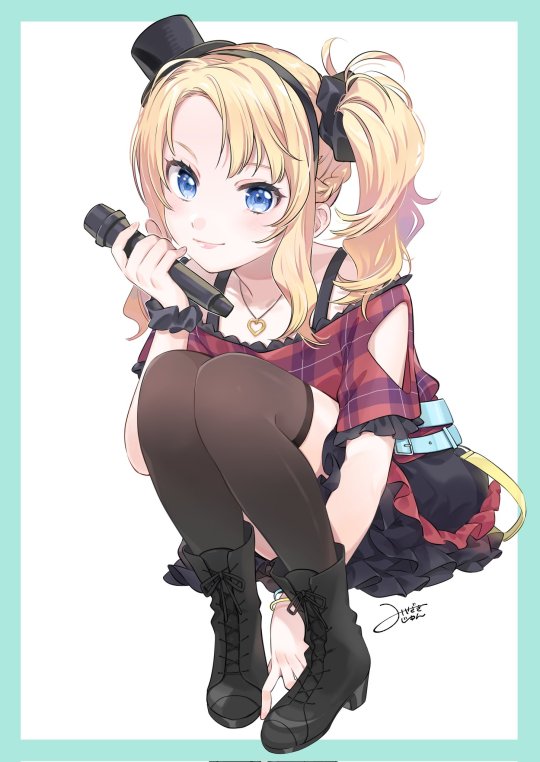
#oficial art#Seishun Buta Yarō wa Orusuban Imōto no Yume o Minai#aobuta#aobuta series#Seishun Buta Yarō wa Yumemiru Shōjo no Yume o Minai#Seishun Buta Yarō wa Siscon Idol no Yume o Minai#seishun buta yarou wa yumemiru shoujo no yume wo minai#seishun buta yarou wa bunny girl senpai no yume wo minai#seishun buta yarou series#rascal does not dream#rascal does not dream of a dreaming girl#rascal does not dream of bunny girl senpai#Shoko Makinohara#Rascal Does Not Dream of a Sister Venturing Out#青ブタ#bunny girl senpai#Kaede Asusagawa#nodoka toyohama
4 notes
·
View notes
Photo

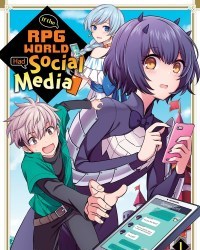




Reader’s Corner: Haruhi’s Intution, Social Media in the RPG World, and a Rascal and Sister Home Alone
Rascal Does Not Dream of a Sister Home Alone
Keji Mizoguchi’s Rascal series draws you in by the banter between Sakuta and his harem (particularly Mai), but really hinges on the believability of the Adolescent Syndrome (the mysterious happenings to the the protagonist and the girls around him) in each volume. I have issue, also, with the entire foundation of the concept and how Mizoguchi tries to explain it away, but when the stories hit their stride, I’m able to mostly forget that and other problems that take me out of the story and become drawn into the narrative at hand. The early portion of Sister Home Alone—in fact, the first two-thirds—were burdened by uneven writing and that believability problem, most demonstrated through Kaede, a character who has until now mostly functioned as the quirky little sister, but now takes center stage as the focus of this volume. The struggle comes in really seeing her as more than funny element, as one that is an authentic and struggling character, trying to over the anxiety that has pressed her down since her own bout of Adolescence Syndrome (sudden bruises that appear on her body when reacting to social situations after having endured relentless bullying two years prior). She’s created in a way that fits both the “cute little sister” mold one who is experiencing mental illness, and it feels quite cringey. That is, until the final third of the volume, where the plot comes together in a surprisingly masterful stroke. I won’t ruin the surprise—and indeed, it doesn’t feel like much of a surprise at first, but ends up driving the narrative toward a strong ending which demonstrates that Mizoguchi’s improved writing the previous series volume, Rascal Does not Dream of Siscon Idol, wasn’t an aberration, and led me to a better evaluation (if not fully) of the first 2/3 of this volume. Better yet, another storyline that runs side by side of Kaede’s in Sister Home Alone sets the stage for even greater drama in the next volume, ending the light novel on a very nice bit of momentum, and for the first time, making this reviewer eager to reach of what Rascal is dreaming of next. ~ Twwk
Rascal Does Not Dream of a Sister Home Alone is published by Yen Press.*
If the RPG World Had Social Media, Vol. 1
It’s the hero’s job to save the world from the demon lord, but how can that happen when the hero is a level-one weakling who can’t even defeat a slime and has always been a shut-in? Too shy to speak to anyone face to face, “Hero” sticks to texting through his phone. Once he finds out about his journey to stop this evil threat and save the princess who was kidnapped, he decides to text the demon lord and finds out she’s a teenage girl! Of naturally, instead of vanquishing her, they start chatting via text. Featuring plenty of comedy and poking fun at isekai and texting norms, there really isn’t much to the story, at least not in volume one. The characters were silly, which is fun, but not much happens besides texting and the princess hitting on the demon lord whilst enjoying her stay in her castle. I hope the following volumes push the story further to see what else can happen besides just texting (though to be fair, group texting occurs in the story since the hero is too shy to speak to each of the demon lord’s generals directly, so I suppose that’s progress). Maybe they can use Facebook or another social media platform next time? ~ Samuru
If the RPG World Had Social Media is published by Yen Press.*
The Intuition of Haruhi Suzumiya (Haruhi Suzumiya, Vol. 12), hardcover
More than nine years after the last volume in the series dropped, The Intuition of Haruhi Suzumiya was finally released last November, digitally to English-speaking audiences the same day as in Japan, and just recently in a physical edition in the U.S (The hardcover copy, by the way, is a nice touch—it’s not anything special, but it reminds me of school hardcovers, and so in that way adds itself to the tone of this school life series). It features three tales—two shorter, previously released chapters, and a long one entitled, “Tsuruya’s Challenge,” focusing on a mystery presented to the S.O.S. Brigade by Tsuruya which the club, together with a visitor, untangle through three apparently autobiographical narratives. Those who have waited for nine years may be disappointed with the lengthy, wordy, detective novel-deconstructing story, but then again, perhaps not, as it’s precisely what fans of the franchise should expect—a continued deeper dive into the Brigade characters (and friends) via conversation and mystery, even if said mystery only advances the plot a tiny bit. Yet, the time spent with these characters and the drops of information which—and is especially stressed in the novel in a meta way—will pay off down the line, that is, if the series ever concludes. We may be in for several more years of waiting for another novel, if we even get one. But somehow, even if we don’t, Intuition has felt from the very first announcement of its release a blessing, and with the volume bookended by a simple but touching recollection about several KyoAni staff who perished in the terrible 2019 fire, another piece that should be cherished, and for which Haruhi fans should be thankful. ~ Twwk
The Intuition of Haruhi Suzumiya is published by Yen Press.*
Sankarea (Series)
Sankarea is a fascinating series. At it’s core, it’s a romantic dramedy about a girl and a boy from different walks of life who end up connecting over a zombie obsession. Oh, and within the first chapters, the girl turns into a zombie herself after a failed suicide attempt and her father accidentally killing her. Yeah, that happens. The series then touches on a variety of complex topics, including self-care, family issues, emotional abuse, romance, and God complexes, all within the confines of an 11-volume series about a boy obsessed with zombies and the zombie girl he falls for. I wasnt sure what to expect, but this enjoyable series defied any expectations I could have had anyway. ~ MDMRN
Sankarea is published by Kodansha.
High School Debut, Vol. 1
Recently I decided to venture into some “shojo classics,” and started with High School Debut, a manga about a young woman who wants to leave her softball-loving junior high days behind and instead pour her energy into finding a boyfriend in high school. With the help of a “coach” (a popular male upperclassman), she hopes to turn her dream into a reality. Maybe because when I started reading, I was only expecting to have a good laugh here and there, but I was completely caught off guard about how much this manga reminded me of being a freshman in high school. The mangaka writes a realistic story of a young woman who genuinely is exhaustively giving her all (and willing to give more!) in order to become attractive to guys. I think because of Haruna’s bright personality, it didn’t make me feel silly that I was once very much in her shoes, even if I didn’t play sports or read manga. Meanwhile the coach, Yoh, may be harsh in his critiques and the advice he gives, but he actually tells Haruna things that (for the most part) should really be taken to heart by a young woman. One quick example is of Yoh telling Haruna that she shouldn’t date just anyone that likes her or wants to date her because otherwise it could lead to her being in a very questionable or creepy situation. Smart thinking. I’m really liking the overall message and Haruna’s bright personality, and am pretty pumped to see where this series goes! ~ Laura A. Grace
High School Debut is published by Viz.
Strobe Edge, Vol. 6
With his relationship with Mayuka now at an end, the doorway seems to be wide open for Ren to date Ninako, and with Valentine’s Day around the corner, the opportunity is just right for the two to finally get together. Right? Right? Of course, this is shoujo, so it isn’t quite that easy—Ren may have feelings for Ninako, but has a clearer understanding of “love” than any other character in the series, and as such, it isn’t easy for him to move on from the love he had with Mayuka. And Ninako, if nothing else, worships Ren so much that out of consideration, she wants to give him the space he needs. Oh, and there’s Ando, too, doing more than just lurking in the wings. As in volume five, he continues to mesmerize me here, though this time sharing the stage with Ren through their broship; he also ends up on the receiving end of a stunner at the volume’s conclusion, which is then followed by a one-shot that Sakisaka had previously developed, a pretty interesting concept for a romance and one I wouldn’t have minded reading if it was serialized—a good inclusion to this transitional volume of the series. ~ Twwk
Strobe Edge is published by Viz.
=====
Reader’s Corner is our way of embracing the wonderful world of manga, light novels, and visual novels, creative works intimately related to anime but with a magic all their own. Each week, our writers provide their thoughts on the works their reading—both those recently released as we keep you informed of newly published works and older titles that you might find as magical (or in some cases, reprehensible) as we do.
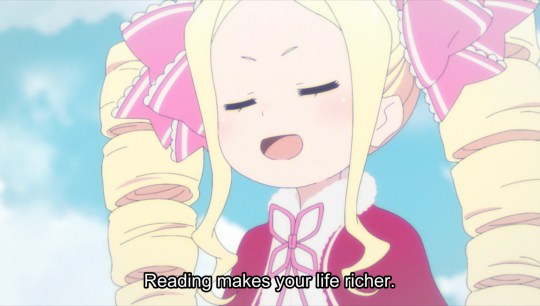
#Manga#Light Novels#Rascal Does Not Dream#Seishun Buta Yarou#If the RPG World Had Social Media#Moshi Role Playing Game no Sekai ni SNS ga Attara#Haruhi Suzumiya#Suzumiya Haruhi#Sankarea#Sankarea: Undying Love#High School Debut#Koukou Debut#Strobe Edge#Reader's Corner#Articles#Author: TWWK#Author: Samuru#Author: MDMRN#Author: Laura A. Grace
3 notes
·
View notes
Text
Tangles Writers Do Not Dream of Bunny Girl Senpai, Arc 4: Authority Gone Wrong

Our short series on Rascal Does Not Dream of Bunny Girl Senpai has demonstrated the sort of love / hate relationship sleepminusminus and I have with anime, and particularly with the lead character, Sakuta. Sometimes, he says and does things that are good; sometimes, he’s not so good; and most often, he’s giving both good and bad advice and encouragement.
But as we conclude the series for now, I want to pull our perspectives upward a bit. Instead of zoning in on Sakuta (or any of the girls), I want to look at the ones who caused the mess in the fourth arc (Rascal Does Not Dream of Siscon Idol for the light novel readers)—Mai and Nodoka’s parents.
In these episodes, Adolescent Syndrome strikes again, this time causing Mai to switch bodies with her half-sister Nodoka, an aspiring idol who looks up to her older sister. However, the siblings’ relationship is complicated by how their mothers use them in a “proxy war.” Both Mai and Nodoka as embittered by this, and struggle with their feelings toward each other.
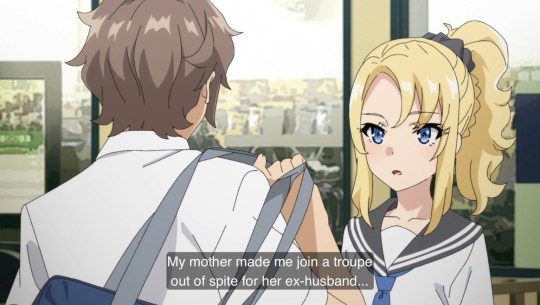
We don’t get to see the girls’ shared father, who seems to be the top culprit, at all in this arc; he’s barely mentioned. Instead, Mai’s mother and Nodoka’s take a more primary role and are presented as tiger parents, pushing their children to succeed at almost any cost and guiding with the hand of a taskmaster. The exaggeration here that presents these ladies as caring 100% for their own selves and not at all for their daughters well being nonetheless presents a shard of the truth that resembles the experience for many during their own childhoods.
In fact, Mai and Nodoka seem to be unrealistically well-adapted for having such awful moms. To me, they seem to act like girls with “regular” tiger moms, at least toward the better end of what can result from that kind of parenting. I’ve seen this in many friends and acquaintances, running the spectrum from literal runaways who became drug addicts (a best childhood friend of mine among them) to those more like Mai and Nodoka, high achievers who are good-hearted though they still struggle with the repercussions of that style of parenting—namely that their relationship with one another is tied up in knots.
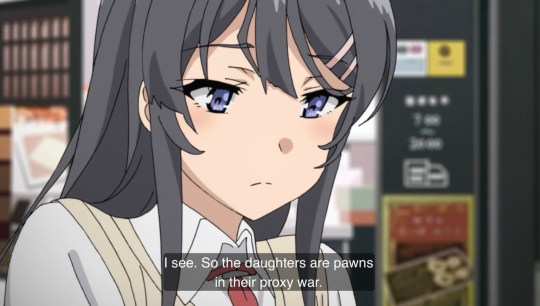
In the world of Rascal Does Not Dream of Bunny Girl Senpai, fantasy, (pseudo)science, and Sakuta’s determination resolves each case of Adolescent Syndrome. But when someone is harmed by an authority figure in real life, the road towards resolution is far more complex. Many of us have been in challenging relationship situations like those facing Mai and Nadoka—but as the readers of this blog age, there’s an opposite concern as well, that we will grow up to be like Mai’s mom and Nadoka’s, those with authority who harm others under our care.
Parenting is probably the most intimate way we can alter someone’s path in a harmful way, but we needn’t be in that position to still be like Mai’s mother in someone’s life. We can be managers in the workplace who treats employees flippantly or teachers who sanctimoniously manage a classroom without considering how each student’s needs are different. We don’t even have to be as intentionally cruel as she is.
Here’s another situation in which we can harm in a similar way—we could do it by serving at a church.
Last year, I started attending a new church, and the transition into it has also been a transition away from the hurt I went through at a previous one. Almost two years gone, I still struggle with processing that pain and loving the church as an institution. Likewise, working through these issues has lead to me to reflect on my own sin and the hurt I’ve caused others—intentional or not, known or not—by participating in and promulgating in a culture that led to my own hurt, not to mention the very direct things I’ve said and done that led to painful results.

Relationships, futures, and faith can be broken by even well-meaning authority figures, much less by those with little care.
I’m not alone being on either or both sides of such pain. Many are suffering from their experiences in church culture, and far more than I have. There’s a movement happening right now of individuals who have left the church and / or faith entirely because of experiences that once started with love and passion but ended with bitterness and regret. A recent, public example is the anger thrown Joshua Harris’ way by those roughly my age who grew up under his proposed system of “Christian courtship” rather than more traditional dating, and how it impacted their relationships and lives. Harris apologized for the harm and he himself, once a very famous author and megachurch pastor, left the pulpit, divorced his wife, and renounced his faith.
It’s such a strange thing that service to God can we warped into that “bad parent” type of mentality through leadership. But it’s actually pretty easy to let a subtle sort of pride, often disguised as Christian humility, invade a church, with leadership imparting advice as if it’s the gospel, and interacting with others and leading small groups and programs with a human-inpinged authority rather than a Christ-centered one, justifying themselves when things don’t seem go right and taking it as a reward for godliness when it does. And I’m not even talking about a megachurch pastor here—I’m speaking just of my own actions as a lay leader!
And James lays it out really well, explaining that we should be wary when instructing others: “Not many of you should become teachers, my brothers, for you know that we who teach will be judged with greater strictness. For we all stumble in many ways. And if anyone does not stumble in what he says, he is a perfect man, able also to bridle his whole body.”
When I was younger, I took that verse more leniently than I should have. I led so many small groups, discipleships, bible studies, and church classes (including one about Haibane Renmei!) without proper wisdom and humility. Looking back, I see how inadequate I was, not only with wisdom but in a lack of sincerity and love with which I approached the position. If those who participated were not drawn off the narrow path, it’s only by God’s grace.
Perhaps like I was in, you’re in a position of authority now—in church, at work or school, as a parent—or if not, you may be there one day soon. I implore you that as you do, you would take God’s word seriously and understand that as an authority figure, the person under you could follow your words into a fire that harms them, and much like those who have burned in church, it could unwittingly be something that doesn’t light aflame immediately, but which over time and even eternally profoundly impacts them.
In Rascal, Mai and Nodoka are able to work out their problems with Sakuta’s intervention, and many who have likewise been impacted in such a way, including those harmed by the church, are able to also. But it can be a long road back. It’s difficult to underestimate how deep our hurts can run and how powerful the words and actions of authority figures can be. Though we’re not likely to undergo an actual physical transformation as a manifestation of our pain, like Mai and Nodoka do, we’re also not likely to undergo a healing that’s magically instantaneous either. The Holy Spirit can and will work (and will other avenues, including good counseling), but at the end of the day, we remain frail humans and may only recover slowly, or in the worst case, not at all.
With wisdom, fear, humility, and kindness, though, those in leadership can still do good work. We can still accomplish much, and love and help others, even though we all are bound to stumble along the way. But if you’re unprepared to be a teacher, a leader, a pastor, a shepherd, an elder, a manager, a director, or a parent, you must either prayerfully and with godly council accept and do your best to be ready, or maybe pass on the duty until you’re able.
For there are worst things a harmful authority can do to others than make them switch bodies with a sibling. Fantasy is fantasy, and reality? Well, in reality, the endings aren’t always happy.
=====
Thank you for joining us for this series of posts on Rascal Does Not Dream of Bunny Girl Senpai. If you’re just finding us now, please check back and read the other posts we’ve written:
Arc 1: Acknowledging Who You Are
Arc 2: To Drop or Not to Drop
Arc 3: Rio, You Don’t Have To Hate Yourself
Arc 4: Authority Gone Wrong
#Anime#Christianity#Rascal Does Not Dream of Bunny Girl Senpai#Seishun Buta Yarou wa Bunny Girl Senpai no Yume wo Minai#Authority#Leadership#Humility#Articles#Author: TWWK
0 notes
Text
Rascal Does Not Dream of Siscon Idol
By Hajime Kamoshida and Keji Mizoguchi. Released in Japan as “Seishun Buta Yarou wa Siscon Idol no Yume wo Minai” by Dengeki Bunko. Released in North America by Yen On. Translated by Andrew Cunningham.
Last time I said that the book felt a bit quieter than the first two, and that goes double for this one, which I definitely enjoyed but which feels a little bit insubstantial compared to the previous books. Part of this could be that there does not seem to be any sort of danger of things being catastrophic if things don’t work out as with previous books. Nodoka’s issues do matter, don’t get me wrong, and I feel for her, but you are 100% not surprised at the solution to this particular adolescence syndrome, and honestly I feel it might have been able to be solved even earlier. That said, having it drag on does help to really hammer home the crux of those issues, and the fact that if there’s going to be any changing and growing being done, it’s going to have to be on Nodoka’s side – Mai, despite being as blunt as her boyfriend at times, is doing just fine.
As with most of this series, the book picks up where the previous one left off, with Sakuta confronted with a Mai who isn’t. When “Nodoka” also shows up, clearly with Mai’s personality, it rapidly becomes clear what’s happened. The issues involved are fairly straightforward – Nodoka and Mai have different mothers, and Nodoka’s mother wants her to be a top idol just as Mai is a top actress, which has led to stress. So Nodoka has run away and swapped bodies. Turning to Mai for comfort is not really working out for her, as Mai is not a comfort sort of girl. Plus this means she has to hang around with Sakuta all the time, who is… well, see the previous three books. She’s astonished Mai is going out with him. Unfortunately, as with prior “syndromes”, knowing the issues doesn’t solve the problem. What’s worse, they each have to take on each other’s career, and, well, one of them is much better at it than the other.
This book emphasizes that family is not something you can narrow down to “I love them” or “I hate them” in absolute terms, and that’s the book’s highlight, as I think it does a good job showing that. Midway through, Sakuta has a very awkward dinner with his father, and we get to see exactly why he feels rather ambiguous about him. At the same time, he’s also searching for thoughts on what being a parent is like to help Nodoka, and gets good, if oblique, advice. Nodoka, fitting with the “annoying little sister” box she sort of falls into, can be sympathetic, especially watching Mai in Nodoka’s body being an even better idol than she normally is, but I 100% agree with Sakuta that her over the top reaction of walking into the ocean to “drown” herself, knowing he’ll stop her, is really irritating. Fortunately, the resolution is cute. That said, one thing this book does do that won’t snap back is Mai and Sakuta’s relationship, which is now public. Fortunately, Mai is very good at damage control.
The next book’s title implies we’re going to focus on Sakuta’s own little sister next time, as she seems to be wanting to return to school… maybe. I get the feeling it will be a bit less relaxed than this book. Still, this is a decent enough volume, especially if you love Sakuta simply saying whatever he’s thinking at the time, no matter how bad it will be for him.
By: Sean Gaffney
0 notes
Text
Seishun Buta Yarou wa Logical Witch no Yume wo Minai

Author: Hajime Kamoshida
Illustrator: Kenji Mizoguchi
Label: Dengeki Bunko
Release Date: 10 January 2015
English Release: This series has been licensed in English by Yen-Press. This volume will likely be titled Rascal Does not Dream of Logical Witch.
Art Notes: There’s a colour illustration of Rio in a bath and it’s pretty fan-service-y. I was disappointed when I saw it because Rio is in high school and is clearly uncomfortable about her breasts and her body and I thought that the anime did a good job at avoiding the use of the male gaze so I was sad the light novel did not do the same and I think that being the first colour illustration you see when you open the volume lessens the impact of her arc.
SPOILER WARNING: There will be spoilers in this post. I accidentally ended up writing it assuming that the reader will have seen the anime adaptation of this volume which was my mistake but I don’t want to rewrite it. I didn’t go too in-depth with the spoilers but I did briefly end up talking about the resolution for the volume so be warned.
This is Rio’s volume and the phenomenon here is "doppelganger”. I think this volume is a good example of what I mean when I say that this series biggest strength is in how relatable it’s characters are. I personally had a similar experience to Rio when I was going through puberty where my body started to feel like the enemy and I hated it and I started to hate myself as a result so, while the source of my problem was different from Rio’s, I totally get what Rio is going through here. My mental state never got as bad as to upload pictures of myself like Rio did but I do understand her motivations and her mindset feels like those of a high school girl and I feel like the author did his research and likely consulted several women about their experiences in puberty. And I like that Rio’s conclusion is not that she accepts and loves herself; it’s that she realises that she does not have to go to such lengths to receive love from others. She’s still got a long way to go to being okay but she’s getting there. It’s not perfect but I do think that it’s a lot better than most portrayals of teenage girls that I have seen in light novels.
That being said, I’m not sure that relatability really justifies the sheer amount of pointless scenes that aren’t even funny. A scene where Sakuta makes guesses about what underwear Tomoe is wearing under her yukata does fuck all but leave me frustrated. It’s like the characters themselves feel realistic and relatable but the way that the characters talk is far from it. The dialogue leaves me feeling frustrated and I hate it.
The most off-putting part in this volume is the part where Sakuta is teaching Shouko (who’s in her first year of middle school so I assume she would be about 12) how to bath a cat and Shouko ends up with her white dress soaked and Sakuta just normally offers her a shower and a change of clothes. This is fine but Mai then confronts Sakuta and he protests that Shouko is still just a kid, to which she says that she’s still a girl. She then justifies her words by asking Shouko if she still bathes with her father to which she doesn’t and somehow this works and Sakuta thinks that Shouko is not that much of a kid (ah, yes, the two genders: bathes with dad and bathes without dad). I do think that Mai has reason to be suspicious of Sakuta’s intentions towards Shouko since she resembles the girl who changed his life but this scene was just bizarre to me and it took me out of the narrative entirely.
So, yeah, I enjoyed Rio’s parts of this volume and I thought they were relatable but there were those bits that really annoyed me as I was reading so I couldn’t fully immerse myself in the narrative.
Adaptation Notes:
This volume is adapted in episodes 7 & 8 of the anime. The anime keeps most of Rio’s scenes and actually adds a few short scenes for her that I liked but cuts a lot of Shouko’s stuff. In the light novel, we actually get a good idea of what’s going on with Shouko in this volume and the plotline with her cat is resolved but almost all of her scenes are cut for the anime. The other scene that I liked that was cut was a scene where Sakuta consults Nanjou, the reporter from volume 1, about Rio’s situation with her social media account (wihout mentioning Rio by name) and I really liked that he consulted a woman about that and that he followed her advice because it makes Sakuta feel far less perfect, like he does in the anime when confronting Rio about the pictures. The rest of the scenes that were cut were just those annoying dialogue scenes and I am so glad they were cut because I never would have enjoyed the anime had they stayed in.
Like I said at the start, I think the anime does a really good job at avoiding the use of male gaze framing which is important with Rio who does have issues with her body. Even the scenes where she’s in a bath don’t feel particularly lecherous or anything and I think it leads to her arc being much stronger as a result.
Next volume is the Siscon Idol volume, focusing on Mai’s younger sister and their relationship and I’ll be reading it soon, probably.
#Seishun Buta Yarou series#Rascal does not dream series#Hajime Kamoshida#Kenji Mizoguchi#Dengeki Bunko#June 2020#Positive review
0 notes